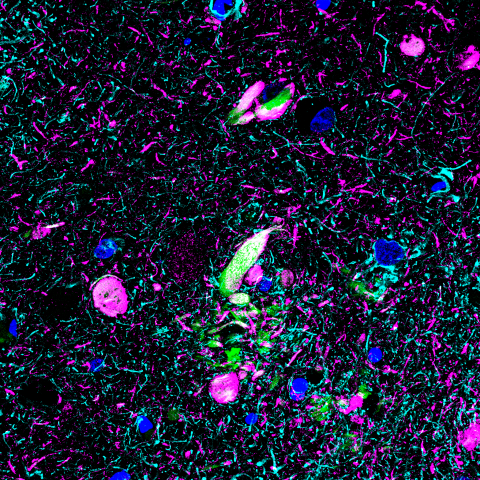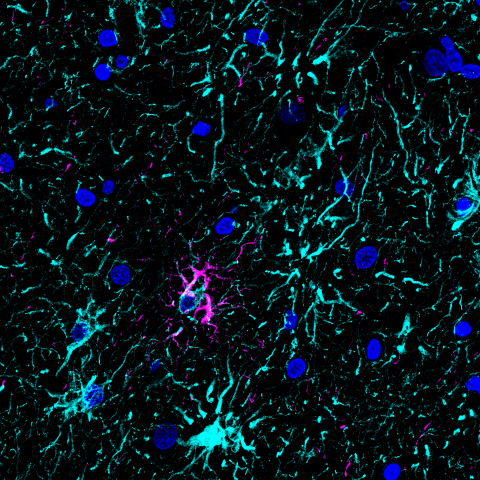Closer: Missing Marker
New University of Iowa research suggests that current brain imaging markers being developed to diagnose neurodegenerative disease may not be catching the full picture in certain cases.


New University of Iowa research suggests that current brain imaging markers being developed to diagnose neurodegenerative disease may not be catching the full picture in certain cases.
These images—submitted by Kimberly Fiock, MS, a PhD candidate in experimental pathology who works in the Marco Hefti lab—show human brain cortex in two different neurodegenerative diseases. The left is from an Alzheimer’s disease patient. The staining shows tau neurofibrillary tangles and neuritic plaque (magenta)—diagnostic hallmarks of the disease. The green staining is thioflavin S, a dye used to highlight a toxic conformation—or shape—of a protein called an amyloid.
Amyloids can be found in many neurodegenerative diseases, and several proteins can form amyloids—including tau, beta amyloid, and alpha synuclein. The left image shows that the tangles and neuritic plaques in Alzheimer’s disease are amyloids because the magenta and green staining overlap. New PET imaging tracers being developed to diagnose neurodegenerative diseases detect these amyloids using dyes that are derived from thioflavin.
The right image shows the brain cortex of a patient with progressive supranuclear palsy (PSP), a disease that affects the frontal and temporal lobes of the brain and is part of a larger group of diseases called frontotemporal dementias. PSP is another disease that is diagnosed by the accumulation of tau protein (magenta), which is found in cells called astrocytes (cyan). Unlike what’s seen in Alzheimer’s disease, there’s no thioflavin (green) staining in the astrocytic or neuronal tau accumulations, suggesting that the protein aggregates in PSP are not amyloids.
These images are included in a 2023 paper published in the Journal of Histochemistry and Cytochemistry showing that across all frontotemporal dementias, none have thioflavin-positive amyloids (green) despite tau staining. Why amyloids form in certain diseases, such as Alzheimer’s, and not in others, such as PSP, is not well understood, but this research suggests that new imaging tracers based on thioflavin S derivates won’t work for certain diseases.
